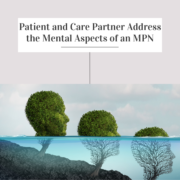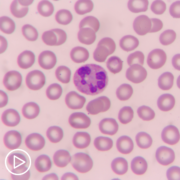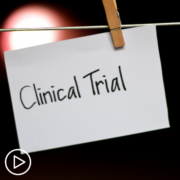Tag Archive for: Myelofibrosis
Patient and Care Partner Discuss Value in MPN Care
Patient and Care Partner Discuss Value in MPN Care from Patient Empowerment Network on Vimeo.
MPN Empowerment Leads Jeff and Summer talk about how they define value in Summer’s care. For instance, one important thing that brings value to them is how accessible their healthcare team is. Watch now to hear more about what they value on Summer’s journey with myelofibrosis.
Transcript
Jeff:
Alright Summer, I’m just looking at the bill for your last doctor’s appointment.
Summer:
Wow.
Jeff:
Do you think we get good value for our money? Oh. Hi, I’m Jeff.
Summer:
HI, I’m Summer.
Jeff:
And we’re your Patient Empowerment Network Network Leads for myelofibrosis. And we’re here to talk to you today about how do you define value for your healthcare dollar. What do you think is important for healthcare dollars, Summer?
Summer:
Well, really important is that the doctor and all the medical staff really listen to the patient and really aware of how the patient is doing everything. Also, that they need to explain because my doctor will come up with little charts with funny little numbers on them and something about blasts which doesn’t have anything to do with blasting like having fun. So, she’ll come out with that and explain all that.
Also, to let you know what’s going on with your medication. Where I get my medication is Walgreens Specialty Pharmacy and they’re very good. They always call me about any changes. They let me know when the order’s in. They always offer to delivery it, but I don’t think that’s a very good idea so I do pick it up.
Also, that they see the patient as an individual and respect their individuality. For example, I’m big on mind-body connection. I think there’s a huge connection doing exercise daily, eating pretty good, but I do like my sweet treats too. I don’t give that up. And Zelda, she just likes to lay around, and that’s what she enjoys. Don’t you, baby?
Jeff:
Well, a couple of things that I think are important for your value for your healthcare dollar, one is accessibility. Is your doctor easily accessible? And with the UCSD system that we’re on, we have great accessibility. They have a wonderful patient portal on the web that you can go and find out all of your results. I don’t have to keep a book of past blood test results because it’s all on the web and I can see it. And if we want to get in touch with them, there’s a way to send them a message and they get in touch with us within the day for sure. And we can make an appointment that way. It’s really, really a good system. So, accessibility is one thing that’s really important.
Another thing is availability of specialists. Myelofibrosis is a very, very rare and unusual disease and there aren’t a lot of specialists in the whole country. We’re truly blessed to have Dr. Tanaka who is a researcher and a specialist is myelofibrosis and myeloid diseases be on call when Summer showed up at the hospital with her first incidence that led to this diagnosis. And UCSD has a number of doctors that are specialists, so we are fortunate. But you need to find a healthcare system where you have enough specialists.
And the final thing that I can think of is, you need to be your own advocate. The doctor is doing the best they can, he or she can, to solve your problem and to work within what they think is normal standard, normal practice, but they’re not mind readers. They can’t understand what is concerning you. You need to speak up, ask questions, and let the doctor know your concerns so they can address them. That’s the patient’s job as opposed to the healthcare system or the doctor’s job. Speak up.
So those are some of the ways we define value in our healthcare ‘Til next time, I’m Jeff.
Summer:
Summer. Zelda.
Advice for Hesitant MPN Clinical Trial Participants
Advice for Hesitant MPN Clinical Trial Participants from Patient Empowerment Network on Vimeo.
What should MPN patients know about clinical trials? Dr. Claire Harrison from Guy’s and St. Thomas’ Hospital in London shares information about the varying degrees of clinical trials and advice to those who are hesitant about clinical trials.
See More from Best MPN Care No Matter Where You Live
Related Resources:

|

|

|
Transcript:
Dr. Nicole Rochester:
It’s said that clinical trials are tomorrow’s medicine today, and you’ve already kind of alluded to the importance of clinical trials as it relates to MPN. What would you say to an MPN patient who is on the fence or may be concerned or afraid of participating in a clinical trial?
Dr. Claire Harrison:
It’s right to be cautious and, you know, careful because ultimately it’s a huge privilege as a clinician that involves patients in clinical trials that my patients trust me and trust my team to look after them with something that is experimental, but remember there are varying degrees of experimental. Most clinical trials are not first in man, you’re not a complete guinea pig, it may be a drug, for example, navitoclax is in clinical trials mainly for myelofibrosis also ET and PV but that is a drug that has been used for thousands of patients, for another indication so talk to your healthcare team, if you don’t find the answer from the primary person that you’re used to dealing with, find someone else, be linked to somebody you trust and that you have a good relationship with, take someone with you to the consultation, write down the questions I’m so sure you say this all the time, don’t you Nicole to the people that you talk to, but write down your questions, don’t be afraid to ask them again, there is no stupid question in this context, you will be given a 30-plus page booklet to read, and I lost count of the number of times, my patients go, yeah, I’ve got this, or I trust you.
Actually, you know, you need to read it…we are experimenting on you, and you need to read that and understand. And you need to understand, what happens if I go on the control arm, will I be able to cross over? How many visits will I have, will I have to pay for those visits, etcetera. It’s all really important. But ultimately the relationship with your healthcare provider is important, and using an advocate is really important too.
Dr. Nicole Rochester:
I agree 100 percent. So important, these are things that I talk about all the time, so I really appreciate that you highlighted that, and just the importance of patients taking an active role in their medical care and also the trust that is required between the patient and their treating providers. So I really appreciate that. Do you have any examples, Dr. Harrison, in your own practice of successes with MPN patients who have participated in clinical trials?
Dr. Claire Harrison:
Oh yes, I think I started doing clinical trials, well golly, a long time ago. I think my first clinical trial, probably the records were written parchment to be honest, but we’ve still learned a lot from that, so that was an ET study. It was from that study we understood about the JAK2 mutation, and we understood how patients behave differently. I think probably the most gratifying thing for me was being involved in the JAK inhibitor studies in myelofibrosis and being involved in delivering ruxolitinib and Jakafi to patients and seeing the benefits for those patients.
Big things, you know, there are patients who are alive because they took part in that trial today, I think, but there are also patients for whom small things were also really important, so as a patient, that’s important to define what is the benefit you want to get. So one of my first patients, you haven’t been able to have a bath or a shower for years, because he had terrible what we call aquagenic pruritus, itching induced by contact with water, we called him two days after he started ruxolitinib (Jakafi), and he was in tears, he could take…or you can take it out.
These things are really important. Like myself, I can imagine not being able to dig it out, I would either be very tough for another patient, it was, well, I looked really skinny because I’d lost loads of weight and I put weight on, and body image was really important as well, but then the small things like being able to be…participate more in family activities is really, really important too.
How Are MPN Treatments Changing for Low-Risk vs High-Risk Patients?
How Are MPN Treatments Changing for Low-Risk vs High-Risk Patients? from Patient Empowerment Network on Vimeo.
How do MPN treatments vary for low-risk and high-risk patients? MPN expert Dr. Claire Harrison from Guy’s and St. Thomas’ Hospital in London explains how treatment differs for these patients and changes that she would like to see for care of some patients.
See More from Best MPN Care No Matter Where You Live
Related Resources:

|

|

|
Transcript:
Dr. Nicole Rochester:
How are treatment strategies changing for low-risk and high-risk patients with MPN?
Dr. Claire Harrison:
It’s complicated because we need to think across the entities, and we don’t have an answer to that for patients with MPN unclassified. And we don’t actually have a good answer to that for this entity called pre-fibrotic myelofibrosis, which does appear and is strongly recognized in the new diagnostic criteria. But for ET, for example, low-risk patients I mentioned triple-negative, calreticulin, M-positive, young patients, platelets less than 1500, not too much changing their queries about aspirin or not, and then for PV patients, we haven’t really changed all kind of high-risk criteria and for both ET and PV, the questionnaire is, should we use the treatment above aspirin or above aspirin and venesection.
And for the most part, that would be hydroxycarbamide, hydroxyurea (Hydrea), which is the commonest treatment used worldwide or interferon, and these are the right treatment for some patients and not the right treatment for other patients, so some patients can be very fixated on interferon is the absolute best, but there is no clear evidence of that, and there are some patients who interferon is not the right treatment, but low versus high risk becomes even more important for myelofibrosis patients.
And here, we’re thinking about using a risky strategy like transplantation for those patients who have higher risk disease, and we’re using, as I mentioned to you, these molecular markers and newer prognostic tools to stratify patients. And it is important to remember as a patient if someone puts your data into a prognostic tool and that comes up with five years, but it doesn’t mean to say five years on the dot your time’s up, that’s an average. And if we put your data into a slightly different tool, we might get something else. So for the most part, we make decisions like transplants, we are learning more about transplantation and outcomes from that, and then in some countries, some treatments are used for patients who fall into intermediate or high-risk categories, and some clinical trials are based on that as well. I would want to say about myelofibrosis, and something I think I would really like to see changed, not changing yet, but changed, is that we should be able to intervene for patients with a low-risk disease. If my myelofibrosis patients have breast cancer, we would not be going there, then you’ve got low-risk disease, we’ll put you on watch and wait, watch and wait is really hard for our patients, we know that I can see you nodding.
You know that too, right? So if these were patients with breast cancer we would not say, we’ll just watch and wait. So I would really like to see in the next five to 10 years a treatment that we could use earlier in the disease course, but there is nothing at the moment, but we’re looking at that. The other thing we’re looking at, if we’ve got a minute or so is the different endpoint, so we’re trying to understand what does it mean if your allele burden, so the amount of abnormal genes you’ve got goes down, the amount of bone marrow fibrosis you’ve got goes down. And again, this is something we’ll collect in a clinical trial, but also from real-world data.
MPN Patient and Care Partner Breakdown Terminology
MPN Patient and Care Partner Breakdown Terminology from Patient Empowerment Network on Vimeo.
MPN Empowerment Leads Jeff and Summer share how overwhelming medical terminology can be. Jeff encourages everyone to ask your healthcare team questions whenever you need to. He shares that asking the right questions is part of becoming an empowered patient.
Other Videos Featuring Jeff and Summer:

|

|

|
Transcript:
Jeff:
Hi, I’m Jeff.
Summer:
I’m Summer and this little darlin’ is Zelda.
Jeff:
And we’re your MPN Network Managers (Editor’s Note: Network Managers are now referred to as Empowerment Leads) for the Patient Empowerment Network. Here to talk to you today about medical terminology, which often is very confusing. Isn’t it, Summer?
Summer:
Yes, I would say very confusing. And Dr. Tanaka told me oh, you need to take a bone marrow test to determine what kind of myelo, I’m writing this down, myeloproliferative neoplasm. Anyway, Jeff can explain all that to you. To determine all that and I thought, oh my god this is so confusing. She said – she kind of set me straight and made me realize that this is really important.
Jeff:
And, so, we didn’t know, neither of us, what these things meant originally. Dr. Tanaka explained some of it to us pretty well, but then I went home and I’m interested in this, so I became, I’m Summer’s caregiver. And I started doing research, and that’s what I’m going to give you some pointers that I found.
First of all, specific words you can probably Google and find on the web and they’ll tell you want it means. There are a number of organizations that specialize, in our case myeloproliferative neoplasms and blood diseases. The LLS, Leukemia and Lymphoma Society is one of them, and the MPN Research Foundation is another. And there is plenty of information here on Patient Empowerment Network about these diseases.
So, you need to find out the answers to the questions that you have. And you will probably do some of this on your own because you’ll have, when you have your appointments with your doctor you need to ask the questions. There’s no question that should not be asked, and your doctor will be able to tell you. If you are blessed with a good care team, they’re going to have the ability to explain to you what’s going on with your disease in simple terms and terms that mean something to you. And we are truly blessed to have Dr. Tanaka who is able to do this wonderfully.
So, ask those questions, do your own research, you need to become an empowered patient. That’s what we had to be here at Patient Empowerment Network. So the more you know about this unusual disease, in our case – in Summer’s case, myelofibrosis, or other myeloproliferative neoplasms, which by the way that means cancers of the blood produced by the bone marrow, and we found that out. So, you need to become an expert on this kind of stuff yourself because you need to become an empowered patient. That’s our advice to you.
Until next time, I’m Jeff.
Summer:
Summer and I have another bit of advice. Being married or involved with someone who, like Jeff, had all this interest, if you’re not into medical things, helps a lot because I never really think about it very much. I depend on Jeff who does a great job.
Jeff:
Thank you very much, dear.
It’s part of our concept that we’ve told you about before. You’re really apart of a team. You have the caregiver, the patient, and your healthcare provider. So, become a strong team and you’ll be an empowered team.
Until next time, I’m Jeff.
Summer:
I’m Summer and this is Zelda.
What Healthcare Trends Are Observed in MPNs?
What Healthcare Trends Are Observed in MPNs? from Patient Empowerment Network on Vimeo.
MPN Empowerment Leads Jeff and Summer share trends they’ve observed since Summer’s initial diagnosis of myelofibrosis a few years ago. They share recent studies they’ve viewed and are following. Jeff gives a charge to viewers to be your own empowered patient and keep up with research when you can. “Be your own advocate.”
Videos Featuring Jeff and Summer:

|

|

|
Transcript:
Jeff:
Hi, I’m Jeff.
Summer:
And I’m Summer.
Jeff:
And we’re your Network Managers (Editor’s Note: Now referred to as Empowerment Leads) for Myeloproliferative Neoplasms for the Patient Empowerment Network. And, we’re here today to talk to you about healthcare trends in MPN medicine, basically.
Summer:
I was diagnosed with myelofibrosis over three years ago. And at the time, they could only offer me one medication, Jakafi (ruxolitinib), which for me work but doesn’t work for everybody. So, I’ve had good luck with it and I haven’t really had any other symptoms.
Jeff:
But this is an exciting time in the MPN medicine because since that time, there have been two more medications released to control myelofibrosis. One called fedratinib. And just last month, pacritinib was released and approved by the FDA. So now there are three medications that can be used to treat the symptoms of myelofibrosis.
There are currently no medications that can cure a person of myelofibrosis. The only cure, currently, is a stem-cell transplant. But some exciting developments are happening that may even be able to cure it.
I just read an article that some scientists have found that the medication used in breast care – breast cancer treatment causes remission in bone marrow fibrosis in mice. So they’re working along the way to see if that will be effective in humans, eventually. And that might be, potentially, a cure for myelofibrosis. Those are exciting trends in the MPN research and medicine world.
Summer has other information that’s useful though.
Summer:
Yeah, that’s really exciting about the new medication. I was looking up what the Mayo Clinical has to say and being happy and having a good attitude really enhances the immune system. There is a chemical that you get that comes from being happy that really, really keeps the disease from being more serious.
So anyway, that’s what I believe in because I’m an actor and so I don’t get into the medical thing, but I know Jeff is brilliant for it. So, that’s exciting all along having a good attitude and the new developments in medication.
Jeff:
So, keep those in mind, consult with your healthcare provider, and you need to be your own empowered patient and keep up with the research by yourself. It’s all available online, no problems at all, just Google it and you’ll be able to keep up yourself. You have to be your own advocate.
Until next time, I’m Jeff.
Summer:
I’m Summer and, wait a minute, this is our little baby, Zelda.
New Developments in MPN Care
New Developments in MPN Care from Patient Empowerment Network on Vimeo.
Does myeloproliferative neoplasm (MPN) care have new developments? Dr. Kristen Pettit from Rogel Cancer Center shares MPN research updates she hopes to hear about at ASCO 2022.
See More From the MPN TelemEDucation Resource Center
Related Resources:

|

|
Transcript:
Dr. Kristen Pettit:
Yeah, so the ASCO 2022 meeting will certainly be exciting for MPNs, I’m expecting the abstracts haven’t been selected yet as of the time we’re discussing this, so I’m not sure exactly what’s going to be discussed. But what I’m hoping to hear more about is the investigational JAK inhibitor momelotonib for patients with myelofibrosis, specifically those with anemia, I’m hoping to see more results about that.
I’m hoping to hear more about the up-front combination studies that are ongoing in myelofibrosis, so JAK inhibitors plus novel agents compared to JAK inhibitors alone as the first treatment option for patients with myelofibrosis. I’m hoping we get some interim results or updated results from some of those ongoing studies, and I’m hoping to hear more about some of the later line treatment options for patients with myelofibrosis as well.
There are a lot of exciting things going on out there, and we’ve gotten a couple of great updates over the last year, for example, at the ASH meeting in December, and I think we’ll get some more exciting updates at ASCO in May and June.
Why Is Specialized Care Important for MPN Patients?
Why Is Specialized Care Important for MPN Patients? from Patient Empowerment Network on Vimeo.
Specialized myeloproliferative neoplasm (MPN) care is an option for many patients. Dr. Kristen Pettit from Rogel Cancer Center explains various ways that specialized MPN care can benefit patients and MPN conditions that specialists are commonly trained in.
See More From the MPN TelemEDucation Resource Center
Related Resources:

|

|

|
Transcript:
Dr. Kristen Pettit:
I do think it’s important for patients to have an MPN specialist in their corner when they’re living with an MPN, that things are moving very quickly in the MPN fields in all areas, from diagnosis to risk stratification, to treatment and management over time, as well as monitoring.
So I think having someone who focuses specifically and only on MPN to is up-to-date on the most recent literature and the most recent advances, I think is an important thing, even if that’s somebody that you only maybe see either in person or virtually once a year, once every other year, or just have available if anything changes in your disease course.
So most MPNs specialists are certified in both hematology and oncology, but most focus on really all of the MPNs, these are relatively rare conditions, so most MPNs specialists will focus on ET, PV, myelofibrosis, other rare MPNs such as chronic neutrophilic leukemia, and sometimes some of the other myeloid malignancies such as myelodysplastic syndrome, for example, but your MPN doctor most likely focuses on all of those different disorders and would be able to manage your care if heaven forbid, things progress down the road from one of those MPNs to another.
Notable New MPN Treatments
Notable New MPN Treatments from Patient Empowerment Network on Vimeo.
What’s the latest in myeloproliferative neoplasm (MPN) treatments? Dr. Kristen Pettit from Rogel Cancer Center gives updates about treatment developments for myelofibrosis, polycythemia vera (PV), and essential thrombocythemia (ET) care including JAK inhibitors, BCL-2 inhibitors, BCL-XL inhibitors, BET inhibitors, and others.
See More From the MPN TelemEDucation Resource Center
Related Resources:

|

|

|
Transcript:
Dr. Kristen Pettit:
There are so many new treatments in MPNs that I’m excited about, so one that is investigational that has been moving through the pipeline is momelotonib, which is a newer JAK inhibitor for patients with myelofibrosis. The mechanism of action is slightly different than the other JAK inhibitors, ruxolitinib (Jakafi), baricitinib (Olumiant), and pacritinib that’s improved as well.
The hope with momelotonib is that it will do some of the good things that the other JAK inhibitors do reduce symptoms and reduce spleen size, but also potentially improve anemia for patients who struggle with anemia, which is such a high proportion of our patients with myelofibrosis. I think that’s one exciting thing, another exciting avenue are new potential up-front treatment strategies that are being studied, so there are a number of different clinical trials going on right now, testing the strategy of either standard ruxolitinib or Jakafi by itself compared head-to-head versus a combination of Jakafi plus another medication.
Those other medications that are being tested in trials include the BET inhibitor called parsaclisib, also BCL-2, BCL-XL inhibitor called navitoclax, and a Pi3 Kinase inhibitor called parsaclisib. These upfront head-to-head treatment strategies are going to be very important to keep an eye out for over the next couple of years. The hope is that these combination strategies could deepen responses and potentially prolong responses when a new drug is combined with the JAK inhibitor as the first treatment option for patients with myelofibrosis. In the later line setting, one thing that’s exciting is Imetelstat, which is a telomerase inhibitor.
This is the first study in my myelofibrosis that is trying to specifically prove whether or not it is linked in survival for patients with myelofibrosis. So, I think that’s very exciting and something to keep an eye out for.
In polycythemia vera, one newer treatment option that’s getting a lot of excitement is the Hepcidin mimetic called rusfertide, this medication will hopefully harness the body’s iron metabolism pathway and act as sort of a chemical phlebotomy as opposed to an actual therapeutic phlebotomy in order to control the hemoglobin and hematocrit for patients with PV as well as improve symptoms.
In ET the newer agents that are being investigated include the BET inhibitor parsaclisib, is also being studied for myelofibrosis as well as an LSD-1 inhibitor called bomedemstat. Both of these look exciting so far, as far as their ability to both control platelet count and improve symptoms for patients with ET.
How Can You Access an MPN Clinical Trial?
How Can You Access an MPN Clinical Trial? from Patient Empowerment Network on Vimeo.
How can MPN patients access clinical trials? Dr. Ruben Mesa provides tips and resources for patients to learn more about participating in an MPN clinical trial.
Dr. Ruben Mesa is an international expert in the research and care of patients with myeloproliferative neoplasms (MPNs). He serves as executive director of UT Health San Antonio MD Anderson Cancer Center in San Antonio, Texas. More about this expert, here.
See More From MPN Clinical Trials 201
Related Programs:

|

|

|
Transcript:
Katherine:
Dr. Mesa, let’s move on to participation. How can someone find out about what trials are available to them?
Dr. Mesa:
So, first and foremost, it begins with a conversation with your physician. And overall, clinical trials – the majority of clinical trials are in situations where things are not going perfectly. You know, if you’re doing well, you’re feeling well, you’re doctors a hundred percent happy with how you’re doing, then a clinical trial may or may not be an option. They are usually in a situation where things are not going as well as we would like. You have residual symptoms; you’ve only had a partial response.
If the current medicines for the disease don’t agree with you, you had side effects, or others. Now additional research for learning about these trials include many different organizations. There are disease-specific ones, like the MPN Research Foundation, MPN advocacy & Education International, MPN Hub, amongst many others. There is the broader, clinicaltrials.gov. Now, that’s a very broad site.
It is searchable. Sometimes it gives you more information than is helpful, but most things are listed on there. The Leukemia and Lymphoma Society, at LLS.org, has a specific kind of navigation function that they have for learning more about clinical trials and getting matched up with them.
But it truly starts with you and your doctor. If things aren’t working well, what are the options that I have? Is it a different option in terms of therapy? Or, if not, asking about clinical trials because clinical trials, again, will have their own upsides and downsides you and doctor will go through depending upon your situation.
Katherine:
What are the barriers to accessing clinical trials? Are there any?
Dr. Mesa:
So, first, clinical trials have, kind of, the broader logistics barriers. Frequently, you need to enroll and participate at a particular site and sometimes that site is not locally. Your doctor may or may not be participating in that trial. Some trials are only done at a single institution. So, for many, there can be a hassle factor.
You know, it’s impractical for me to be there, or be there for the frequency of visits or other pieces. So, that is one potential barrier. Overall, we hope that insurance or other coverage is not a barrier. In general, clinical trials are structured in a way to hopefully have them be financially neutral for patients.
It’s not less expensive to get your care if you’re on a trial, but it shouldn’t be any more expensive because the standard of care items are billed to your insurance as they would be normally. But if there are things that are experimental, they are included as an expense of running the trial and you’re not charged for those. Now the other barrier is, specifically, trials tend to have a specific set of eligibility for participation that are medical. It may be in a subset of patients based on any number of factors.
And there may be other limiters in terms of prior health conditions, sometimes in terms of age, sometimes in terms of how well the heart, the liver, the kidneys, or other things work. There’s both kind of a logistical piece, but then there is very specific eligibility. As a researcher, when a patient is a candidate for a clinical trial, I will have to go point by point, and sometimes there might be 50 points of disease, blood tests, and organ function – other pieces that need to be correct for participation in that trial.
It’s not to say that drug may not conceivably help that individual. It’s to say that for that specific trial, that’s what’s needed to participate in that very specific clinical trial.
So, sometimes that can lead to a bit of frustration, but it’s critical so that that trial is comparing the right group of patients so that the safety is really as great as the safety can be in the conduct of that study.
Katherine:
Right. What sort of questions should patients be asking their healthcare team about participating in a clinical trial?
Dr. Mesa:
Well, I think this discussion acts as a nice framework. So first, why should I participate in this clinical trial? Meaning, what is it about my disease that makes a different treatment option a consideration? So, why to begin with? And, if so, why this trial? What drug is it? Why does it help? If it was successful, what can I expect?
Then, what is entailed with me to participate? How frequently do I need to come? What’s involved? Is there more expenses that I can anticipate?
Again, in general, I can hopefully say no. But, of course, if you’re having to fly once a month, that, in some trials, may be covered as an expense of the trial and you’re reimbursed, but it may not. So, again, I think it starts with, medically, why does it make sense? What is involved for me? And then, really, what are those other next steps? And then, what are the alternatives? Sometimes there’s more than one clinical trial as an alternative. Sometimes there’s other options that are not a clinical trial that are an alternative to consider as well.
Katherine:
Before we end the program, Dr. Mesa, I’d like to get your thoughts. What message would you like to leave the audience with related to clinical trial participation?
Dr. Mesa:
Clinical trials are essential.
They are really the only way that we make progress in terms of developing new treatments. In the United States, less than 10 percent of patients with diseases like MPNs and cancers participate in clinical trials. And, to be honest, this really slows our ability to develop new therapies that would benefit folks. These are a very important resource.
I’ll flip it around another way – in children, where, again, we want to do everything that we can – about 80 to 90 percent of children are treated in the conduct of a clinical trial, where, again, they’re constantly pushing the envelope to try to develop better therapies.
And because of that, I think our progress comparatively, in childhood cancers, has been much faster in developing therapies than it has been in adults. So, it’s critical. It’s an opportunity.
Again, it’s very much a personal decision, but it’s something that I would strongly encourage you to consider. Again, one can begin and you are not obligated to remain on if that clinical does not, in the end, end up having the benefit that you had hoped, or if it ends up having a side effect that you prefer to not experience.
MPN Clinical Trial Safety, What Are the Protocols?
MPN Clinical Trial Safety, What Are the Protocols? from Patient Empowerment Network on Vimeo.
Safety is a top concern for many patients considering clinical trial participation. Dr. Ruben Mesa explains the protocols put in place to minimize a patient’s risks.
Dr. Ruben Mesa is an international expert in the research and care of patients with myeloproliferative neoplasms (MPNs). He serves as executive director of UT Health San Antonio MD Anderson Cancer Center in San Antonio, Texas. More about this expert, here.
See More From MPN Clinical Trials 201
Related Programs:

|

|

|
Transcript:
Katherine:
Let’s talk about safety. What are the risks of a clinical trial participation?
Dr. Mesa:
So, clinical trials are structured to try to have the safety be front and center in terms of caring for patients.
So, depending upon the therapy and how much is known about that therapy will dictate the frequency in which the patient is observed. If there’s specific side effects, how are we monitoring for those side effects so that, if they are starting to occur, we can discontinue it, discontinue the drug, lower the dose, etc. So, there are some times we do accept as patients and as physicians some potential new side effects in the hope that a therapy might be more effective against the disease.
So, if it might irritate the eye, do we have eyes exams? If it might cause the heart rhythm to be abnormal in some way, do we monitor electrocardiograms? If it might cause rash, do we have exams at a certain frequency to assess for rash? Is there more blood count tests done to assess for changes in the blood counts, irritation in the liver or kidney?
So, depending upon how the drug might impact someone, it really helps to dictate what monitoring is occurring in the conduct of the study to monitor for side effects.
And then there will always be a very specific plan. Well, if a side effect occurs, what do we do? Is the drug stopped? Is the dose lowered? If it’s stopped, how long do we stop it? – usually until that side effect has recovered. And then, do we restart the drug? And, if so, do we restart it at the same dose or at a dose reduction? So, a clinical trial is guided by something that is called a protocol, which is kind of the long recipe book for exactly how that trial will work and will detail all of these things so that it can be done in a thoughtful way, but also in a consistent way, across institutions.
Katherine:
Mm-hmm. Well, that leads me to the next question. I’m curious to know what protocols are in place to protect patients?
Dr. Mesa:
So, it depends very much by each clinical trial.
There are specific protocols in that any clinical trial that is developed needs to be reviewed and approved at multiple levels through an institutional review board, which is in ethics or specifically focus on clinical trials for an institution or sometimes for a broader group. There are times that there’s additional regulatory oversight from the FDA, from the National Cancer Institute, cooperative groups, and others.
So, there’s really an entire network of things put in place. Mandatory training for physicians, nurses, and staff in terms of good clinical practices in the conduct of the study. There are specific safeguards in terms of the handling of the drugs. The pharmacist, and other safeguards in terms of you receive the drug that you’re intended to receive at the right dose, made in the right way.
Everything is heavily focused in medical practice anyway on patient safety, but you can imagine that in the conduct of a clinical trial that’s taken really to the next level in terms of trying to provide every safeguard for the patient.
An MPN Expert Defines Clinical Trial Types
An MPN Expert Defines Clinical Trial Types from Patient Empowerment Network on Vimeo.
What are the types of clinical trials? Dr. Ruben Mesa explains the differences and discusses what patients should expect with each type.
Dr. Ruben Mesa is an international expert in the research and care of patients with myeloproliferative neoplasms (MPNs). He serves as executive director of UT Health San Antonio MD Anderson Cancer Center in San Antonio, Texas. More about this expert, here.
See More From MPN Clinical Trials 201
Related Programs:

|

|

|
Transcript:
Katherine:
You touched upon the various types of clinical trials and I would like to look at each one of them individually. So, let’s start with the double-blind clinical trial. What is that?
Dr. Mesa:
What that refers to is that neither the patient nor the physician knows which of the two comparator arms of the trial are more that a patient receives. So, with a trial, let’s say that there’s more than one way that someone can be treated. Let’s say arm A is drug X, and arm B is drug X plus drug Y, where drug Y is the experimental drug, and drug X is our standard of care. The reason they are double-blinded is that if the physician or the patient know exactly which arm they’re on, that might have an influence in terms of the physician assessing the response of the patient, the patient filling out questionnaires regarding response in symptoms.
It’s natural for us if we’re on a drug to say, “Oh, wow, you know, I automatically feel better. I’m excited about being on this,” and lead to what we call a bit of a placebo effect. Where there have been studies in the past where someone got a placebo but believed they were already feeling better even though nothing different had occurred. So, that they had somewhat kind of convinced themselves they were going to be doing better. So, the intent is, again, just to get the most objective set of response both from the physician and from the patient.
Katherine:
What is a randomized clinical trial?
Dr. Mesa:
A randomized trial means that when there is more than one arm, which treatment that a patient receives is random, is not chosen by the physician. Why that is the case is, again, we truly want to see which approach is better.
If the physician got to choose, they may inadvertently put all the sicker patients on one arm, or put all the less sick patients on one arm. In either case, it would make the value of the clinical trial less.
The value of the clinical trial, the entire reason we do them, is to try to, in the best way that we can, figure out which approach was better, whether that’s a treatment for your MPN, whether that’s figuring out whether a COVID vaccine helps to prevent to COVID, whether it’s figuring out whether a cholesterol lowering medicine is a good medicine to be on. Regardless of the reason, we want to know, is it the right way to go?
Because after that, there will be a lot of people who receive that treatment.
Katherine:
And finally, what is a controlled clinical trial?
Dr. Mesa:
A controlled clinical trial is, again – is following these same pieces where it has a comparator, where that comparator arm is sometimes also called the control, meaning that’s kind of the baseline – and, again, you’re looking to see, does that make a difference a baseline. So, let me use an MPN analogy. When ruxolitinib or Jakafi was first tested, there were no approved drugs for myelofibrosis.
So, how that worked – it was a controlled study. There was randomized placebo control. Half the group got ruxolitinib, half got placebo. After 24 weeks, people could then go on to get the ruxolitinib.
So, everyone eventually got the ruxolitinib. But, for those 24 weeks, we were able to compare what did the standard of care, which was really nothing, against ruxolitinib and saw a dramatic benefit. Now, the newer trials, now that ruxolitinib (Jakafi) is approved, ruxolitinib has been the control.
So, when there was a ruxolitinib and momelotinib trial to see if momelotinib was an effective drug, it was compared against ruxolitinib. Now, it was blinded, so that you didn’t know which of the two that you were on, but people were getting an active control. So, that is an active-controlled trial versus a placebo-controlled trial where the comparator is placebo.
Katherine:
What is an observational study, and how does that differ from the other clinical trials?
Dr. Mesa:
An observational study, as the name might suggest, is, again, where you’re observing a group of individuals, whether they start on a treatment, whether you’re trying to see how the disease behaves over a period of time.
But what it typically does not do is that you are intervening in a very specific sort of way where you are again changing how people otherwise would have been treated.
Understanding Common MPN Clinical Trial Terms
Understanding Common MPN Clinical Trial Terms from Patient Empowerment Network on Vimeo.
Dr. Ruben Mesa explains common terminology used in MPN clinical trials, including adverse events, HIPPA, and placebos.
Dr. Ruben Mesa is an international expert in the research and care of patients with myeloproliferative neoplasms (MPNs). He serves as executive director of UT Health San Antonio MD Anderson Cancer Center in San Antonio, Texas. More about this expert, here.
See More From MPN Clinical Trials 201
Related Programs:

|

|

|
Transcript:
Katherine:
Let’s move on to some common language used around clinical trials. I’ll mention a few and then maybe you could define them for the audience. The first one is, informed consent. What does that mean?
Dr. Mesa:
Informed consent is that what is involved with participating with a trial, what the drug is, what do we know about its safety, what you might anticipate, either in terms of side effects, whether a likely side effect or a rare side effect.
And what’s involved with you in terms of a participation, whom to call if there’s an issue. It really is an extensive document. It looks like a contract, but actually it is not.
So, informed consent is not an obligation to participate in the trial, nor does it mean that you have to stay on the trial for any length of time.
It is truly to inform you, and then you sign it, saying that you have been informed. One important concept: in the clinical trial, you are always in the driver’s seat, so that if you take – you sign the consent and you choose not to participate, you’re done then and there. If you take one dose and you don’t want to take anymore – fine. So, you’re always in the driver’s seat. It looks like a contract; it clearly is not. It is not an obligation from your side.
Katherine:
That’s good to know. What about standard of care?
Dr. Mesa:
So, standard of care is the medical language we use to how we would treat you otherwise. So, a clinical trial, by definition, is we’re trying something new.
Sometimes it’s a drug that’s never been approved, but sometimes it’s a drug that’s approved that we’re testing in a different way. Standard of care is kind of the default care that you would normally receive anyway, that is kind of the medical standard for your particular condition.
Katherine:
What does adverse event mean?
Dr. Mesa:
An adverse event means any possible side effect or event, a hospitalization or something of that nature. And then, the doctor typically attributes whether it’s related or unrelated. So, let me use an example.
If you’re on a clinical trial with a drug, but you go skiing; you fall and you break your ankle. That is an adverse event. You were hospitalized and had a broken ankle during the conduct of the study.
Now, it likely is not attributed to the trial drug, and that’ll be discussed and investigated.
But maybe it was. Maybe you felt light-headed and you passed out because of the drug you were on and you were skiing. So, again, that is a determination that your doctor makes about an adverse event. But it’s an adverse event whether it’s related to the drug or whether it has nothing to do with the drug.
Katherine:
And what about HIPAA? What does that mean?
Dr. Mesa:
HIPAA relates to – and I forget the full acronym – but really, it’s around the integrity of your patient information and that that is not able to be disclosed in a way that is either harmful to you or to individuals that really are not authorized to receive that information, which typically includes your treating team with permission – if you give permission to another healthcare provider or system, to your insurance company, et cetera.
But it’s really around both portability, I believe, in terms of your patient record, but also in terms of privacy.
Katherine:
A big concern for patients who may be considering participating in a clinical trial is fear that they will receive a placebo. Can you define what a placebo is for the audience?
Dr. Mesa:
So, a placebo means a drug that is inert. So, historically, a placebo has been, let’s say, like a sugar pill.
So, one, it is a very small minority of trials in this day and age that have a placebo. So, one, it’s almost solely in the setting of a Phase III trial. So, in a Phase I trial, everyone gets the drug. In a Phase II trial, typically everyone gets the drug. In a Phase III trial, there is typically something that it is compared against.
Now, if there’s a standard of care approach, that’s likely the comparison group.
Now, the group that starts with standard of care may well then have a period where they “crossover,” where they are treated in one way for a certain amount of time, and then get kind of the drug in question. A placebo is truly meant to be the same as kind of getting nothing. Now, in a disease like MPN, the number of placebo control trials is really very few. Sometimes a situation that they are used is where the comparator is, let’s say, trying to use two drugs – so, let’s say, the standard of care plus a new drug – versus the standard of care alone.
Now, sometimes people will take both the standard of care and a placebo so that they are, what we call, blinded. So, they don’t know which treatment arm they were on. They’re still getting treatment. They’re still getting the treatment that they would’ve anyway, but they don’t get two treatments. So, the second part is a placebo.
But anything like this, one – any trial a doctor refers you to, one should fully understand exactly how the trial works. Is it a trial with a placebo? Is it not? And then, allow that to help kinda inform your own consideration.
Is this something that I’m willing to do? Does it make sense? Is there a different approach? You know, is there a different trial that does not involve a placebo? So, I think, as physicians, we clearly understand that we try to absolutely minimize the situation where placebos are used. And when they are used, they are only used in a way that we feel that no one is getting less than at least the standard of care therapy that they would otherwise.
You know, it is unethical for there to be a placebo that really would deny patient a therapy that we otherwise know would be helpful.
Katherine:
Are there other common terms that you think patients should understand and know about?
Dr. Mesa:
As you relate to adverse events, sometimes you would hear the term, serious adverse event, and this is sometimes to separate whether, again, as the name suggests, they are serious – and by serious, that sometimes has a threshold of requiring hospitalization, requiring a visit to the ED, emergency department – to potentially being life-threatening. Now sometimes these are associated with the disease or the medication. Sometimes, they’re unrelated. But these are ones we’re particularly sensitive of.
Again, as one looks at side effects of therapies, you’ll look at an informed consent and typically it will be a fairly long list of possible things. A relatively short list of things that we expect might happen being likely to occur, maybe can occur in greater than 20 percent of people, and sometimes some really rare things that are less likely to occur. But we also look at – when we look at a trial and look at all of the side effects that people had – were they related, were they unrelated, and were they potentially serious or not?
Understanding Clinical Trial Phases
Understanding Clinical Trial Phases from Patient Empowerment Network on Vimeo.
What happens in each phase of a clinical trial? Dr. Ruben Mesa explains the structure of clinical trials and what MPN patients can expect when participating in a trial.
Dr. Ruben Mesa is an international expert in the research and care of patients with myeloproliferative neoplasms (MPNs). He serves as executive director of UT Health San Antonio MD Anderson Cancer Center in San Antonio, Texas. More about this expert, here.
See More From MPN Clinical Trials 201
Related Programs:

|

|

|
Transcript:
Katherine:
What is a clinical trial? Let’s start with that.
Dr. Mesa:
It’s a very good question. A clinical trial is a very structured way for us to be able to ask a question, whether that question is, is a new therapy safe?
Is it effective for a particular disease? Sometimes there are clinical trials that don’t involve treatments, that involve questionnaires, or other interventions, things like exercise or yoga or other things. But in general, it’s where we are having a patient do something in a structured way that we are able to then assess. Is it safe and is it effective? Is it reaching our goal in terms of trying to have an impact on that disease, whatever that is?
So, if it’s a blood pressure medicine, it’s probably about lowering the blood pressure. If it was about the COVID vaccines, did the vaccines help people from developing COVID or make COVID less severe? So, what they’re testing is variable. But the concept is the same.
It’s a very organized way for patients to be able to receive something that is closely monitored, that has been approved in advance as being a reasonable, safe, and ethical to ask patients to participate.
Katherine:
What are the phases of clinical trials?
Dr. Mesa:
So, the phases are particularly to treatment or drug use trials for developing new therapies. And they start with Phase I, which is typically the first time a drug is tested in human beings. It’s already gone testing in the lab to see whether it should work. It likely has had some animal testing to get a sense of dose and safety. But then, the first individuals who receive the drug, it’s on Phase I. What we’re really trying to understand the safety of the drug and to try to get around the dose.
There is the Phase II, typically where we’re testing a therapy in a group of people that are all similar to see what is the effectiveness of the treatment.
So, that first phase is, is the drug safe? What is the dose? The second phase is, is the drug effective? and however we define effective for that particular disease. And then, the third phase is where that new treatment is compared against how we otherwise normally would have treated the disease. So, if that’s in the setting of where we already have a drug that is approved, it’ll be compared against that drug.
If there’s never been a drug, then that comparator could possibly be a placebo, or an inactive part, or observation, or sometimes best alternative therapy the doctors can use.
There is, finally, a fourth phase. There are times that, after a drug is approved, the FDA will ask for additional information – safety information, effectiveness information – even after approval, and that’s something referred to as the fourth phase.
Clinical Trials As an MPN Treatment Option: What You Should Know
Clinical Trials As an MPN Treatment Option: What You Should Know from Patient Empowerment Network on Vimeo.
Should you consider an MPN clinical trial? Dr. Ruben Mesa provides an overview of clinical trials—including the phases—and defines common trial terms and types. Dr. Mesa shares advice on trial participation and gives an update on the latest advances in MPN research.
Dr. Ruben Mesa is an international expert in the research and care of patients with myeloproliferative neoplasms (MPNs). He serves as executive director of UT Health San Antonio MD Anderson Cancer Center in San Antonio, Texas. More about this expert, here.
See More From MPN Clinical Trials 201
Related Programs:

How Should You Participate in MPN Care and Treatment Decisions? |

|

|
Transcript:
Katherine:
Hello and welcome. I’m Katherine Banwell, your host for today’s program. Today, we’re going to discuss research advances in myeloproliferative neoplasms, or MPNs, and review key information that patients should know about clinical trial participation.
Before we get into the discussion, please remember that this program is not a substitute for seeking medical advice. Please refer to your healthcare team about what might be best for you. Well, let’s meet our guest today. Joining me is Dr. Ruben Mesa. Dr. Mesa, welcome. Would you please introduce yourself?
Dr. Mesa:
Thank you so much. It’s a pleasure to be here. I’m Ruben Mesa. I’m the executive director of the Mays Cancer Center at UT Health San Antonio MD Anderson.
Katherine:
Great. Thank you so much for joining us today. As we move through this conversation, we’ll talk about the classic myeloproliferative neoplasms, essential thrombocythemia, polycythemia vera, and myelofibrosis. So, before we dive deeper into our clinical trial discussion, let’s talk about research advances. What are the latest developments in the field of myeloproliferative neoplasms?
Dr. Mesa:
There are many advances that are very important for patients to know about. First, we’re learning more about the biology of these diseases. Why do they occur? Why do they progress? Why are they different in different individuals? Indeed, the course of these diseases can be quite variable. So, these important pieces of biology are important for us to be able to better diagnose the disease, monitor the disease, and develop better therapies.
Second, I would say that there are many important new therapies that are in development. They are only able to be developed into therapies that patients can use by the process of undergoing through clinical trials. But these therapies are for patients with essential thrombocythemia, polycythemia vera, and myelofibrosis. So, a critical part, but many different scientific advances that are important and hopefully will have an important impact for patients with MPNs.
Katherine:
Mm-hmm. It sounds very promising. And, of course, these research advances wouldn’t be possible without patients actually participating in clinical trials. So, can you help us understand more about the trials? What is a clinical trial? Let’s start with that.
Dr. Mesa:
It’s a very good question. A clinical trial is a very structured way for us to be able to ask a question, whether that question is, is a new therapy safe?
Is it effective for a particular disease? Sometimes there are clinical trials that don’t involve treatments, that involve questionnaires, or other interventions, things like exercise or yoga or other things. But in general, it’s where we are having a patient do something in a structured way that we are able to then assess. Is it safe and is it effective? Is it reaching our goal in terms of trying to have an impact on that disease, whatever that is?
So, if it’s a blood pressure medicine, it’s probably about lowering the blood pressure. If it was about the COVID vaccines, did the vaccines help people from developing COVID or make COVID less severe? So, what they’re testing is variable. But the concept is the same.
It’s a very organized way for patients to be able to receive something that is closely monitored, that has been approved in advance as being a reasonable, safe, and ethical to ask patients to participate.
Katherine:
What are the phases of clinical trials?
Dr. Mesa:
So, the phases are particularly to treatment or drug use trials for developing new therapies. And they start with Phase I, which is typically the first time a drug is tested in human beings. It’s already gone testing in the lab to see whether it should work. It likely has had some animal testing to get a sense of dose and safety. But then, the first individuals who receive the drug, it’s on Phase I. What we’re really trying to understand the safety of the drug and to try to get around the dose.
There is the Phase II, typically where we’re testing a therapy in a group of people that are all similar to see what is the effectiveness of the treatment.
So, that first phase is, is the drug safe? What is the dose? The second phase is, is the drug effective? and however we define effective for that particular disease. And then, the third phase is where that new treatment is compared against how we otherwise normally would have treated the disease. So, if that’s in the setting of where we already have a drug that is approved, it’ll be compared against that drug.
If there’s never been a drug, then that comparator could possibly be a placebo, or an inactive part, or observation, or sometimes best alternative therapy the doctors can use.
There is, finally, a fourth phase. There are times that, after a drug is approved, the FDA will ask for additional information – safety information, effectiveness information – even after approval, and that’s something referred to as the fourth phase.
Katherine:
Let’s move on to some common language used around clinical trials. I’ll mention a few and then maybe you could define them for the audience. The first one is, informed consent. What does that mean?
Dr. Mesa:
Informed consent is that what is involved with participating with a trial, what the drug is, what do we know about its safety, what you might anticipate, either in terms of side effects, whether a likely side effect or a rare side effect.
And what’s involved with you in terms of a participation, whom to call if there’s an issue. It really is an extensive document. It looks like a contract, but actually it is not.
So, informed consent is not an obligation to participate in the trial, nor does it mean that you have to stay on the trial for any length of time.
It is truly to inform you, and then you sign it, saying that you have been informed. One important concept: in the clinical trial, you are always in the driver’s seat, so that if you take – you sign the consent and you choose not to participate, you’re done then and there. If you take one dose and you don’t want to take anymore – fine. So, you’re always in the driver’s seat. It looks like a contract; it clearly is not. It is not an obligation from your side.
Katherine:
That’s good to know. What about standard of care?
Dr. Mesa:
So, standard of care is the medical language we use to how we would treat you otherwise. So, a clinical trial, by definition, is we’re trying something new.
Sometimes it’s a drug that’s never been approved, but sometimes it’s a drug that’s approved that we’re testing in a different way. Standard of care is kind of the default care that you would normally receive anyway, that is kind of the medical standard for your particular condition.
Katherine:
What does adverse event mean?
Dr. Mesa:
An adverse event means any possible side effect or event, a hospitalization or something of that nature. And then, the doctor typically attributes whether it’s related or unrelated. So, let me use an example.
If you’re on a clinical trial with a drug, but you go skiing; you fall and you break your ankle. That is an adverse event. You were hospitalized and had a broken ankle during the conduct of the study.
Now, it likely is not attributed to the trial drug, and that’ll be discussed and investigated.
But maybe it was. Maybe you felt light-headed and you passed out because of the drug you were on and you were skiing. So, again, that is a determination that your doctor makes about an adverse event. But it’s an adverse event whether it’s related to the drug or whether it has nothing to do with the drug.
Katherine:
And what about HIPAA? What does that mean?
Dr. Mesa:
HIPAA relates to – and I forget the full acronym – but really, it’s around the integrity of your patient information and that that is not able to be disclosed in a way that is either harmful to you or to individuals that really are not authorized to receive that information, which typically includes your treating team with permission – if you give permission to another healthcare provider or system, to your insurance company, et cetera.
But it’s really around both portability, I believe, in terms of your patient record, but also in terms of privacy.
Katherine:
A big concern for patients who may be considering participating in a clinical trial is fear that they will receive a placebo. Can you define what a placebo is for the audience?
Dr. Mesa:
So, a placebo means a drug that is inert. So, historically, a placebo has been, let’s say, like a sugar pill.
So, one, it is a very small minority of trials in this day and age that have a placebo. So, one, it’s almost solely in the setting of a Phase III trial. So, in a Phase I trial, everyone gets the drug. In a Phase II trial, typically everyone gets the drug. In a Phase III trial, there is typically something that it is compared against.
Now, if there’s a standard of care approach, that’s likely the comparison group.
Now, the group that starts with standard of care may well then have a period where they “crossover,” where they are treated in one way for a certain amount of time, and then get kind of the drug in question. A placebo is truly meant to be the same as kind of getting nothing. Now, in a disease like MPN, the number of placebo control trials is really very few. Sometimes a situation that they are used is where the comparator is, let’s say, trying to use two drugs – so, let’s say, the standard of care plus a new drug – versus the standard of care alone.
Now, sometimes people will take both the standard of care and a placebo so that they are, what we call, blinded. So, they don’t know which treatment arm they were on. They’re still getting treatment. They’re still getting the treatment that they would’ve anyway, but they don’t get two treatments. So, the second part is a placebo.
But anything like this, one – any trial a doctor refers you to, one should fully understand exactly how the trial works. Is it a trial with a placebo? Is it not? And then, allow that to help kinda inform your own consideration.
Is this something that I’m willing to do? Does it make sense? Is there a different approach? You know, is there a different trial that does not involve a placebo? So, I think, as physicians, we clearly understand that we try to absolutely minimize the situation where placebos are used. And when they are used, they are only used in a way that we feel that no one is getting less than at least the standard of care therapy that they would otherwise.
You know, it is unethical for there to be a placebo that really would deny patient a therapy that we otherwise know would be helpful.
Katherine:
You touched upon the various types of clinical trials and I would like to look at each one of them individually. So, let’s start with the double-blind clinical trial. What is that?
Dr. Mesa:
What that refers to is that neither the patient nor the physician knows which of the two comparator arms of the trial are more that a patient receives. So, with a trial, let’s say that there’s more than one way that someone can be treated. Let’s say arm A is drug X, and arm B is drug X plus drug Y, where drug Y is the experimental drug, and drug X is our standard of care. The reason they are double-blinded is that if the physician or the patient know exactly which arm they’re on, that might have an influence in terms of the physician assessing the response of the patient, the patient filling out questionnaires regarding response in symptoms.
It’s natural for us if we’re on a drug to say, “Oh, wow, you know, I automatically feel better. I’m excited about being on this,” and lead to what we call a bit of a placebo effect. Where there have been studies in the past where someone got a placebo but believed they were already feeling better even though nothing different had occurred. So, that they had somewhat kind of convinced themselves they were going to be doing better. So, the intent is, again, just to get the most objective set of response both from the physician and from the patient.
Katherine:
What is a randomized clinical trial?
Dr. Mesa:
A randomized trial means that when there is more than one arm, which treatment that a patient receives is random, is not chosen by the physician. Why that is the case is, again, we truly want to see which approach is better.
If the physician got to choose, they may inadvertently put all the sicker patients on one arm, or put all the less sick patients on one arm. In either case, it would make the value of the clinical trial less.
The value of the clinical trial, the entire reason we do them, is to try to, in the best way that we can, figure out which approach was better, whether that’s a treatment for your MPN, whether that’s figuring out whether a COVID vaccine helps to prevent to COVID, whether it’s figuring out whether a cholesterol lowering medicine is a good medicine to be on. Regardless of the reason, we want to know, is it the right way to go?
Because after that, there will be a lot of people who receive that treatment.
Katherine:
And finally, what is a controlled clinical trial?
Dr. Mesa:
A controlled clinical trial is, again – is following these same pieces where it has a comparator, where that comparator arm is sometimes also called the control, meaning that’s kind of the baseline – and, again, you’re looking to see, does that make a difference a baseline. So, let me use an MPN analogy. When ruxolitinib or Jakafi was first tested, there were no approved drugs for myelofibrosis.
So, how that worked – it was a controlled study. There was randomized placebo control. Half the group got ruxolitinib, half got placebo. After 24 weeks, people could then go on to get the ruxolitinib.
So, everyone eventually got the ruxolitinib. But, for those 24 weeks, we were able to compare what did the standard of care, which was really nothing, against ruxolitinib and saw a dramatic benefit. Now, the newer trials, now that ruxolitinib (Jakafi) is approved, ruxolitinib has been the control.
So, when there was a ruxolitinib and momelotinib trial to see if momelotinib was an effective drug, it was compared against ruxolitinib. Now, it was blinded, so that you didn’t know which of the two that you were on, but people were getting an active control. So, that is an active-controlled trial versus a placebo-controlled trial where the comparator is placebo.
Katherine:
What is an observational study, and how does that differ from the other clinical trials?
Dr. Mesa:
An observational study, as the name might suggest, is, again, where you’re observing a group of individuals, whether they start on a treatment, whether you’re trying to see how the disease behaves over a period of time.
But what it typically does not do is that you are intervening in a very specific sort of way where you are again changing how people otherwise would have been treated.
Katherine:
Are there other common terms that you think patients should understand and know about?
Dr. Mesa:
As you relate to adverse events, sometimes you would hear the term, serious adverse event, and this is sometimes to separate whether, again, as the name suggests, they are serious – and by serious, that sometimes has a threshold of requiring hospitalization, requiring a visit to the ED, emergency department – to potentially being life-threatening. Now sometimes these are associated with the disease or the medication. Sometimes, they’re unrelated. But these are ones we’re particularly sensitive of.
Again, as one looks at side effects of therapies, you’ll look at an informed consent and typically it will be a fairly long list of possible things. A relatively short list of things that we expect might happen being likely to occur, maybe can occur in greater than 20 percent of people, and sometimes some really rare things that are less likely to occur. But we also look at – when we look at a trial and look at all of the side effects that people had – were they related, were they unrelated, and were they potentially serious or not?
Katherine:
Let’s talk about safety. What are the risks of a clinical trial participation?
Dr. Mesa:
So, clinical trials are structured to try to have the safety be front and center in terms of caring for patients.
So, depending upon the therapy and how much is known about that therapy will dictate the frequency in which the patient is observed. If there’s specific side effects, how are we monitoring for those side effects so that, if they are starting to occur, we can discontinue it, discontinue the drug, lower the dose, etc. So, there are some times we do accept as patients and as physicians some potential new side effects in the hope that a therapy might be more effective against the disease.
So, if it might irritate the eye, do we have eyes exams? If it might cause the heart rhythm to be abnormal in some way, do we monitor electrocardiograms? If it might cause rash, do we have exams at a certain frequency to assess for rash? Is there more blood count tests done to assess for changes in the blood counts, irritation in the liver or kidney?
So, depending upon how the drug might impact someone, it really helps to dictate what monitoring is occurring in the conduct of the study to monitor for side effects.
And then there will always be a very specific plan. Well, if a side effect occurs, what do we do? Is the drug stopped? Is the dose lowered? If it’s stopped, how long do we stop it? – usually until that side effect has recovered. And then, do we restart the drug? And, if so, do we restart it at the same dose or at a dose reduction? So, a clinical trial is guided by something that is called a protocol, which is kind of the long recipe book for exactly how that trial will work and will detail all of these things so that it can be done in a thoughtful way, but also in a consistent way, across institutions.
Katherine:
Mm-hmm. Well, that leads me to the next question. I’m curious to know what protocols are in place to protect patients?
Dr. Mesa:
So, it depends very much by each clinical trial.
There are specific protocols in that any clinical trial that is developed needs to be reviewed and approved at multiple levels through an institutional review board, which is in ethics or specifically focus on clinical trials for an institution or sometimes for a broader group. There are times that there’s additional regulatory oversight from the FDA, from the National Cancer Institute, cooperative groups, and others.
So, there’s really an entire network of things put in place. Mandatory training for physicians, nurses, and staff in terms of good clinical practices in the conduct of the study. There are specific safeguards in terms of the handling of the drugs. The pharmacist, and other safeguards in terms of you receive the drug that you’re intended to receive at the right dose, made in the right way.
Everything is heavily focused in medical practice anyway on patient safety, but you can imagine that in the conduct of a clinical trial that’s taken really to the next level in terms of trying to provide every safeguard for the patient.
Katherine:
Dr. Mesa, let’s move on to participation. How can someone find out about what trials are available to them?
Dr. Mesa:
So, first and foremost, it begins with a conversation with your physician. And overall, clinical trials – the majority of clinical trials are in situations where things are not going perfectly. You know, if you’re doing well, you’re feeling well, you’re doctors a hundred percent happy with how you’re doing, then a clinical trial may or may not be an option. They are usually in a situation where things are not going as well as we would like. You have residual symptoms; you’ve only had a partial response.
If the current medicines for the disease don’t agree with you, you had side effects, or others. Now additional research for learning about these trials include many different organizations. There are disease-specific ones, like the MPN Research Foundation, MPN advocacy & Education International, MPN Hub, amongst many others. There is the broader, clinicaltrials.gov. Now, that’s a very broad site.
It is searchable. Sometimes it gives you more information than is helpful, but most things are listed on there. The Leukemia and Lymphoma Society, at LLS.org, has a specific kind of navigation function that they have for learning more about clinical trials and getting matched up with them.
But it truly starts with you and your doctor. If things aren’t working well, what are the options that I have? Is it a different option in terms of therapy? Or, if not, asking about clinical trials because clinical trials, again, will have their own upsides and downsides you and doctor will go through depending upon your situation.
Katherine:
What are the barriers to accessing clinical trials? Are there any?
Dr. Mesa:
So, first, clinical trials have, kind of, the broader logistics barriers. Frequently, you need to enroll and participate at a particular site and sometimes that site is not locally. Your doctor may or may not be participating in that trial. Some trials are only done at a single institution. So, for many, there can be a hassle factor.
You know, it’s impractical for me to be there, or be there for the frequency of visits or other pieces. So, that is one potential barrier. Overall, we hope that insurance or other coverage is not a barrier. In general, clinical trials are structured in a way to hopefully have them be financially neutral for patients.
It’s not less expensive to get your care if you’re on a trial, but it shouldn’t be any more expensive because the standard of care items are billed to your insurance as they would be normally. But if there are things that are experimental, they are included as an expense of running the trial and you’re not charged for those. Now the other barrier is, specifically, trials tend to have a specific set of eligibility for participation that are medical. It may be in a subset of patients based on any number of factors.
And there may be other limiters in terms of prior health conditions, sometimes in terms of age, sometimes in terms of how well the heart, the liver, the kidneys, or other things work. There’s both kind of a logistical piece, but then there is very specific eligibility. As a researcher, when a patient is a candidate for a clinical trial, I will have to go point by point, and sometimes there might be 50 points of disease, blood tests, and organ function – other pieces that need to be correct for participation in that trial.
It’s not to say that drug may not conceivably help that individual. It’s to say that for that specific trial, that’s what’s needed to participate in that very specific clinical trial.
So, sometimes that can lead to a bit of frustration, but it’s critical so that that trial is comparing the right group of patients so that the safety is really as great as the safety can be in the conduct of that study.
Katherine:
Right. What sort of questions should patients be asking their healthcare team about participating in a clinical trial?
Dr. Mesa:
Well, I think this discussion acts as a nice framework. So first, why should I participate in this clinical trial? Meaning, what is it about my disease that makes a different treatment option a consideration? So, why to begin with? And, if so, why this trial? What drug is it? Why does it help? If it was successful, what can I expect?
Then, what is entailed with me to participate? How frequently do I need to come? What’s involved? Is there more expenses that I can anticipate?
Again, in general, I can hopefully say no. But, of course, if you’re having to fly once a month, that, in some trials, may be covered as an expense of the trial and you’re reimbursed, but it may not. So, again, I think it starts with, medically, why does it make sense? What is involved for me? And then, really, what are those other next steps? And then, what are the alternatives? Sometimes there’s more than one clinical trial as an alternative. Sometimes there’s other options that are not a clinical trial that are an alternative to consider as well.
Katherine:
Before we end the program, Dr. Mesa, I’d like to get your thoughts. What message would you like to leave the audience with related to clinical trial participation?
Dr. Mesa:
Clinical trials are essential.
They are really the only way that we make progress in terms of developing new treatments. In the United States, less than 10 percent of patients with diseases like MPNs and cancers participate in clinical trials. And, to be honest, this really slows our ability to develop new therapies that would benefit folks. These are a very important resource.
I’ll flip it around another way – in children, where, again, we want to do everything that we can – about 80 to 90 percent of children are treated in the conduct of a clinical trial, where, again, they’re constantly pushing the envelope to try to develop better therapies.
And because of that, I think our progress comparatively, in childhood cancers, has been much faster in developing therapies than it has been in adults. So, it’s critical. It’s an opportunity.
Again, it’s very much a personal decision, but it’s something that I would strongly encourage you to consider. Again, one can begin and you are not obligated to remain on if that clinical does not, in the end, end up having the benefit that you had hoped, or if it ends up having a side effect that you prefer to not experience.
Katherine:
Dr. Mesa, thank you so much for joining us today. It’s been a pleasure.
Dr. Mesa:
Wonderful. Thank you so much for including me.
Katherine:
And thank you to all of our partners. To learn more about MPNs and to access tools to help you become a proactive patient, visit powerfulpatients.org. I’m Katherine Banwell. Thanks for being with us.




